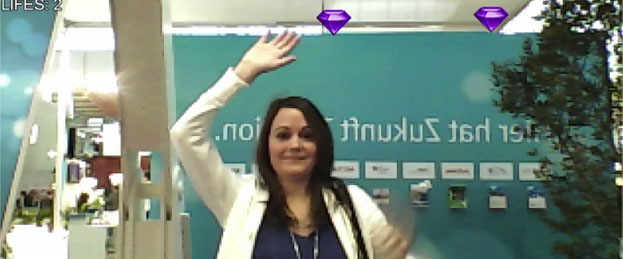Mini-games within the application help to maintain a large varriety in the entertainement process. They challenge the player in other fields than answering questions.
Through the various systems on which the application will be able to run, every mini-game itself determines what requirements it has to be playable on the current system
Before the individual mini-games are developed, these were roughly designed in the storyboard phase.

Catch All and Catch Selected
The games “Catch All” and “Catch Selected” are two mini games that do not work with touch input, but are controlled by the motion detection using a webcam.
Both games are consistent with the concepts of “moving school” or the “dynamic learning”. These state that learning can be improved if the students have to move around. In addition, the movement is a change from the otherwise sedentary playing experience, compensating the inner urge to move.
Both Webcam games have the task of catching falling objects. While in “Catch Selected” just the right answers to a question should be caught, in “Catch All” all objects should be collected.

Since the players in front of the camera needs room to move, the maximum number of players in these two mini-games is limited. But also with regard to the use in the school these players limit is reasonable. If a higher number of players would play it could happen that the players start to jostle in the competition situation to have an unfair advantage. This is prevented by the limitation.
(Note: The game can be played here in a modified form: )
Quick Select
“Quick Select” is a reaction game. Similar to “Catch Selected” the players will be asked questions or given sentences that must be completed. Corresponding solutions are shown by time, so you can see only one answer. Does the player see the correct answer to the question he has to push his “buzzer” or its player key on the keyboard. Is the question answered correctly, points are added to his account and the next question is asked. At a wrong answer and the game continues.
“Quick Select” is the only mini-game where a player can respond to a question several times. With this second chance he can compensate for a wrong answer.
Since the game can be controlled with keyboard and touch input, there are no restrictions on the number of players or the existing hardware, so it is playable on any device.
Defend Your Base

The mini-game “Defend Your Base” is from the genre of “Tower Defense games” (abbreviated TD). Task in this kind of game is to defend the own base. In conventional TD games, it is the responsibility of the player by building defensive structures (usually turrets or towers, hence the term “tower defense”) to defend their own base.
In the implemented version the attacker, represented by red circles, has to be “crushed” with the players fingers. This mini-game was implemented to train the hand-eye coordination of the player.
By the simultaneous interaction at different locations on the screen at the same time, the multi-touch capabilities are completely exhausted in this mini-game.
Since the control via mouse only allowes the interaction with one point at a time, the game is by this type of control more difficult than via touch.
Moreover, the use of the mouse limits the number of players to one person, while on multi-touch devices a higher number of players is possible.
Upcoming blog entries
Making The Game – Part 17: Evaluation and deployment of the application
Making The Game – Part 18: Concept for school use and outlook
